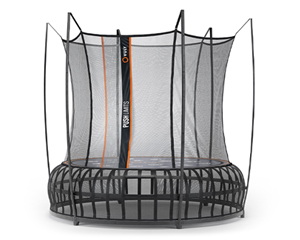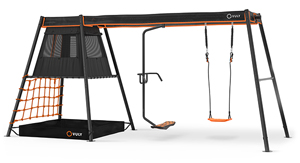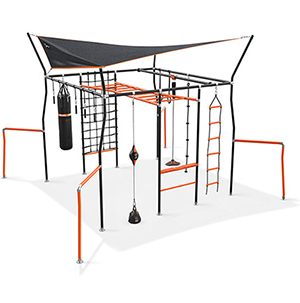Some trampolines are specially designed for carnivals, fairs, summer camps, and travelling shows. To meet the demands of the constant relocation, these devices need to be easily assembled, disassembled, and transported, so commercial trampolines differ greatly from those used for recreation and are generally not recommended for family use.
Shape & Safety Features of Commercial Trampolines
Most commercial trampolines are rectangular in shape and joined together onto one platform. Users usually pay a fee to use the devices and are then allowed access to the trampoline's individual netted area.
The netting allows a group of customers to enjoy a personal trampoline without risking the danger or frustration of coming into contact with other patrons. When the day is over, the entire deck folds neatly and is easily moved to the transporting vehicle.

Commercial Bungee Trampolines
Bungee trampolines are a subset of commercial trampolines and are frequently featured in theme parks, carnivals, and amusement parks. These devices allow jumpers to experience greater rebounds than recreational trampolines provide.
Users are fitted with a snug harness that is connected to the bungee ropes. The bungee ropes, in turn, are attached to the poles outside of the trampoline enclosure. Each jump causes the ropes to be slightly shortened and effortlessly propels the jumper to great heights. Jumpers can then perform flips, turns, and thrilling manoeuvres.

Performance Trampolines
Circus performances are admired for their unbelievable displays of athleticism, agility, and risky manoeuvres. Trampolines are frequently incorporated into circus shows as performance art. These fine-tuned athletic displays impeccably showcase the grace, timing, and talents of the performers.
Some circus trampolinists perform independent shows, while others are part of an acrobatic team. Some trampolinists take performing to another level by leaping on, jumping over, or landing in other objects on the stage.
Trampolining and public performances have long, intertwined histories. In fact, many reports suggest that an artist named Du Trampolin inspired the first informal trampoline. Du Trampolin was supposedly inspired to create a new rebounding device after watching trapeze artists move on safety nets that were positioned underneath their trapezes.
He was especially fascinated by the flair that trapeze artists would display as part of their performance when moving over the safety netting. Du Trampolin realized the potential for the netting to be used in a new, propulsion-filled way.
Although du Trampolin receives credit for inventing the early performance-based trampoline, George Nissen and Larry Griswold are responsible for developing the first modern trampoline in 1935. The original trampoline was composed of the angle iron, a canvas bed, and rubber springs and was originally invented to aid the University of Iowa's gymnastics team.
The two men had noticed several trapeze artists who used their safety nets to rebound and perform additional stunts and decided that trampolining could easily become a sport in its own right. Their idea could not have been any more astute, and trampolines continue to play a central role in performing arts throughout the world.















































